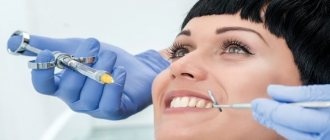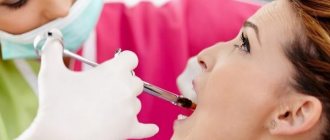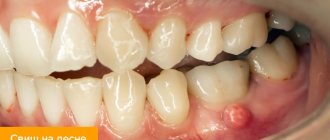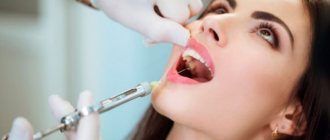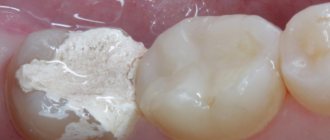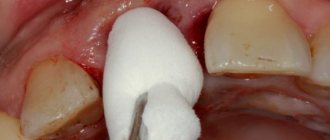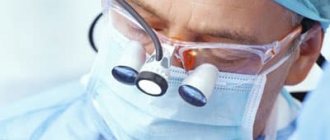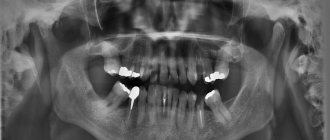05.11.2019
Every person experiences pain while in the dental chair. Most people then become afraid of going to the dentist. Therefore, anesthesia for tooth extraction is a common procedure. The use of painkillers relates to surgical operations, but not on a large scale.
To quickly and painlessly cure or remove a tooth, you need to choose the right anesthesia. Today there are a large number of painkillers. They have been so improved that a person does not feel any pain.
Anesthesia methods
Anesthesia can be local or general. The local form is divided into external and injection methods.
The external method allows you to anesthetize superficial tissues using medicinal substances. These can be special ointments, gels, devices with electromagnetic waves, simply applications. The last method is used most often. The application is a cooling plate. It is applied to the gums, and the patient does not feel pain. This method is usually used to remove baby teeth in children.
The injection method involves injecting an anesthetic substance through a needle.
There are 4 types of anesthesia:
- Conductor. The method allows you to anesthetize several teeth at once. An anesthetic is injected into the area of the last tooth where the branch of the nerve is affected, resulting in blockage of the entire nerve.
- Infiltration. An anesthetic substance is injected into the projection area of the apex of the tooth root.
- Intraligamentous. The medicine is administered through the gum. As a result, the tooth and the surrounding gum area are numbed. For this method, a special syringe with a dispenser is used. It allows you to administer a minimum of anesthetic substance.
- Intraosseous. It is the best anesthesia. In this case, the injection is made directly into the spongy bone. It is she who covers the dental alveoli.
General anesthesia (anesthesia) is done very rarely.
It should not be used for people who have heart problems. This method of anesthesia is used only in the most difficult cases. Dentistry must be equipped with a special office and all the necessary equipment. And also during surgical operations, the presence of an anesthesiologist next to the patient is mandatory.
Only the doctor decides which anesthesia is best for tooth extraction. Everything will depend on the complexity of the procedures and the general condition of the tooth.
How is topical anesthesia performed?
The area of the mucous membrane is dried with a cotton swab. Then a small amount of anesthetic is carefully applied to it with a cotton swab or swab. The drug instantly penetrates 2-3 mm deep - the effect occurs within 30-40 seconds in the case of solutions and after 2 minutes if ointments or gel are used. The anesthesia lasts for 10-15 minutes.
As anesthetic agents in pediatric dentistry, those that meet certain requirements are used:
- soluble in water and isotonic solution;
- demonstrate high resistance to sterilization and stability in solutions;
- have a bactericidal effect and a pleasant taste, which is important for children;
- penetrate well through the epithelial layer;
- provide rapid pain relief;
- do not cause irritation;
- exhibit minimal toxicity upon absorption;
- give a minimum of adverse reactions.
Basic painkillers
Not any anesthesia can be used when extracting a tooth. In dentistry, only the most common and effective medications are used. And almost every hospital has Novocaine.
But in modern treatment, novocaine is used much less frequently. If previously not a single operation could be done without it, now this drug causes an allergic reaction in most people. It has a number of side effects:
- dizziness;
- lethargy;
- lowering blood pressure.
Today there are more intense anesthetics, and therefore novocaine is used only in combination. It is injected into the body with a small dose of adrenaline. In combination, these drugs have the best analgesic functions. But such a mixture should not be prescribed to people whose blood pressure is off the charts.
For infiltration anesthesia, a 0.5% lidocaine solution is used. This drug can be used for the conduction method; only a 1–2% solution is required. For an adult, the norm is 300–400 mg. Side effects of this medicine include:
- headache;
- fatigue;
- loss of sensation in the lips and tongue;
- heart rhythm is disturbed;
- blood pressure decreases;
- there may be hives.
The most modern anesthesia is a medicine based on the substance articaine. Such drugs can provide long-term and reliable pain relief. It is used by a large number of dental surgeons. The substance reaches its maximum effect after 10 minutes and maintains its result for 1–3.5 hours. But no matter how good the drug is, it always has side effects:
- muscle twitching;
- headache;
- tremor;
- nausea;
- vomiting reflex;
- diarrhea.
These are the most common side effects. But sometimes others happen:
- blood pressure decreases;
- cardiac arrhythmia is disturbed;
- rashes appear on the skin;
- angioedema may occur.
These painkillers cannot be used for meningitis, tumors, osteochondrosis, spondylitis, tuberculosis, metastatic lesions of the spine, heart failure, tumors in the abdominal area, severe arterial hypotension, and hemostasis disorders.
Use with caution during pregnancy. The drug may cause a decrease in the fetal heart rate.
A very good drug based on articaine is Ubistezin. It also contains adrenaline. It reduces blood vessels in the area where anesthesia was administered. This makes it difficult to absorb the substance. As a result, the analgesic effect begins to act within 3 minutes. In addition to the above listed side effects that drugs based on articaine have, Ubistezin also adds the likelihood of an ischemic zone in the area where anesthesia was administered. This occurs if a blood vessel has been hit or a nerve has been damaged.
What drugs are used for topical anesthesia?
In pediatric dentistry, solutions, emulsions, ointments, pastes, gels, aerosols are used, as well as special dispersed tablets, caramels and children's chewing gum. They contain highly concentrated anesthetics without vasoconstrictors. Most often, dentists use solutions, sprays and aerosols.
- "Babident" is intended for pain relief during the eruption of primary teeth in infants. Apply 1-2 drops of the solution with a cotton swab or finger to the mucous membrane of the gums 1-3 times a day.
- In pediatric dentistry, Perylene-Ultra solution is often used.
- The most popular gels and pastes are “Xylonor”, “Instilagel”, “Aroma paste carried”, Jen-Dental, Xyligel.
- The most commonly used ointments are 2-3% dicaine, 5% lidocaine, 2-3% falicaine, etc.
Removing wisdom teeth
Anesthesia for wisdom tooth removal is no different from conventional means for treating other teeth. The doctor decides independently how to administer the medicine depending on the specific situation.
Most often, wisdom teeth are removed not because they are affected by caries, but because of their abnormal location. As a result, these teeth have the pathology dystopia or retention.
- Dystopia is the process of eruption of a wisdom tooth that is displaced towards the cheek or tongue.
- Retention is when a wisdom tooth has formed but has not erupted through the gums. In this case, the dentist makes an incision in the gum, removes the wisdom tooth and stitches the incision. Typically, such surgical procedures are performed under local anesthesia.
Spray irrigation method
According to the results of clinical studies, the most pronounced analgesic effect in the treatment of caries of temporary teeth is provided by sprays and aerosols, for example Lignospam, Lidokain 10%, Legekain, etc. Anesthesia occurs after 30-40 seconds and lasts for 15 minutes. Due to their unpleasant taste, gels and aerosols are contraindicated in children under four years of age, as they increase salivation and can enter the respiratory tract and cause respiratory arrest.
Older children also complain of local symptoms after irrigation - numbness of the laryngeal tissue, sensation of a lump in the throat, hoarseness, which sometimes lead to breathing problems. Therefore, before using sprays and aerosols, the dentist must tell the patient how to behave correctly and make sure that he has accepted the information. This type of anesthesia can only be done while exhaling, but it is safer to apply the product to a cotton swab and apply it to the area, similar to liquid solutions.
Removing baby teeth
Milk teeth that can no longer be cured, but they provoke the development of acute inflammation of the bone or periosteum, must be removed. Which method to use will depend on the specific situation.
For example, the milk tooth being removed is already well loosened and the pain when pulled out will be minimal. In this case, the doctor may advise putting on an application, gel or aerosol.
Lidocaine aerosol is used quite often. There are 3 mg per 1 kg of body weight. For children, it is better to apply this substance using a cotton swab.
For more serious dental problems, children are given infiltration anesthesia. Lidocaine, Ubistezin Forte and similar medications are used. Two injections are made - from the gum and from the tongue.
Children tolerate these painkillers well. But before using them, it is necessary to undergo tests to identify allergens. It is also worth clarifying whether the child has problems with the cardiovascular system.
What is the difference between pediatric anesthesia and adult anesthesia?
Features of pediatric anesthesia are determined by the characteristics of the child’s body.
For example, a child’s body needs 2 times more oxygen than an adult. Also, the children's body is characterized by a rapid change in physiological states and an increased ability to adapt. At the same time, children are more sensitive to changes in ambient temperature, have increased emotionality, and find it difficult to remain in one position for a long time. There is a high probability of allergic reactions in children, and the smaller the child, the more caution you need to choose the drug.
Therefore, when performing pediatric anesthesia, the following rules must be observed:
Accurately select the anesthetic drug and its dose. There is some difficulty in treating pain in children under 4 years of age, because... Most local anesthetics are used from the age of 4. For a child prone to allergies, it is better to conduct special allergy tests to know exactly which drug is safe for him.
The anesthetic should be administered to the child as gently as possible. Children are often afraid of tools, and even more so of syringes. Before the injection, the needle insertion site should be treated with a tasty anesthetic gel, which “freezes” the gum. Today, a large selection of such drugs is available.
Due to increased sensitivity to ambient temperature, a child may feel cold during treatment in a cool room, or vice versa - hot if the room is poorly ventilated and too small. This factor must be taken into account.
Do not neglect the method of premedication before visiting the dentist. Taking a sedative will help your child relax and be less afraid.
A very important component is the doctor’s personality. A good pediatric dentist finds an approach to parents and children and turns fear into interest. Advice to parents: help him with this to the best of your ability.
Anesthesia after tooth extraction
After the tooth has been removed and the anesthesia has begun to wear off, pain may occur. Sometimes the pain symptoms are very strong and unbearable to endure. In this case, they resort to repeated anesthesia. The most common pain reliever offered by dentists is Ketanov.
Ketanov is able to relieve a person from severe and sharp pain.
It is often prescribed after surgery. The drug can be used every six hours, but not more than one week.
Like any medicine, Ketanov has side effects. These include:
- drowsiness;
- dyspeptic disorders;
- the appearance of dry mouth;
- accelerated heartbeat.
The drug should not be taken by people who have:
- bronchial asthma;
- ulcer of the duodenum and stomach;
- kidney diseases.
It is also undesirable for women to use during lactation and pregnancy.
If after three days pain or swelling occurs again, you should immediately consult a doctor.
Medicines you shouldn't take
Many people use homemade medications for pain relief. But they have low efficiency and can provoke undesirable results:
- Aspirin. The medicine is intended to perform an antipyretic function. The analgesic effect is minimal. Aspirin is a good blood thinner. This may lead to delayed bleeding. Although this medicine is included in many painkillers.
- Paracetamol. The drug can only cope with mild headaches. It has no anti-inflammatory effect and has a negative effect on the liver. Included in painkillers as an adjuvant.
- No-shpa. Many people think that this medicine is a pain reliever. But that's not true. No-spa is an antispasmodic drug that only eliminates pain associated with spasms. The pain after tooth extraction is completely different and no-spa will not be able to cope with it.
Anesthesia doesn't work
There are cases when the anesthesia does not work and the person feels pain. There are several factors why this happens:
- Alcohol. The chemical composition of ethyl alcohol can block the effects of the anesthetic. Therefore, it is not recommended to go to the dentist if you have recently consumed strong drinks.
- Using large amounts of painkillers. If a person is taking medications that contain painkillers, they should not be taken before seeing a doctor.
- A person may have individual immunity to certain anesthetics. This factor is very rare.
If the anesthesia does not work, then it is worth understanding the reason. Having received the result, the treatment is postponed to another day.
What is premedication and when is it needed?
Premedication is taking special sedatives in advance of visiting the dentist. It is also effective in children, so we draw the attention of parents to this method of relieving attacks of fear.
Pain has 4 factors:
- sensory sensitivity is the physical cause of pain,
- psycho-emotional mood of the patient,
- autonomic component, caused by overload of the autonomic nervous system,
- motor component.
That is, the more the child is afraid, rushes about and is in a state of stress (mobilization of the autonomic nervous system), the more painful it is for him. If you see that persuasion, stories and other tricks do not work on the child, then it is better to use medication than to cause irreparable harm to the child’s psyche.
It is best to discuss which sedatives are appropriate in this situation with your pediatrician. For safe home remedies, you should try a decoction of valerian or motherwort roots. You need to drink it 1-3 days before going to the dentist in accordance with the doctor’s instructions, according to the child’s age.
Eating after removal
It is not recommended to eat salty and spicy foods after tooth extraction. They irritate the mucous membrane and increase pain. Consuming hot food and drinks can cause bleeding and increase swelling.
Many people have been afraid to eat ice cream for a long time, claiming that they will catch a cold. Cold food has no effect on this. This problem can be caused by general hypothermia of the body or a draft. The main thing is to eat the ice cream slowly and not bite into large pieces. This delicacy is even recommended, because it forces the blood vessels to constrict, which means that there is no risk of bleeding.
Category: Tooth extraction Published by Mister stomatolog
